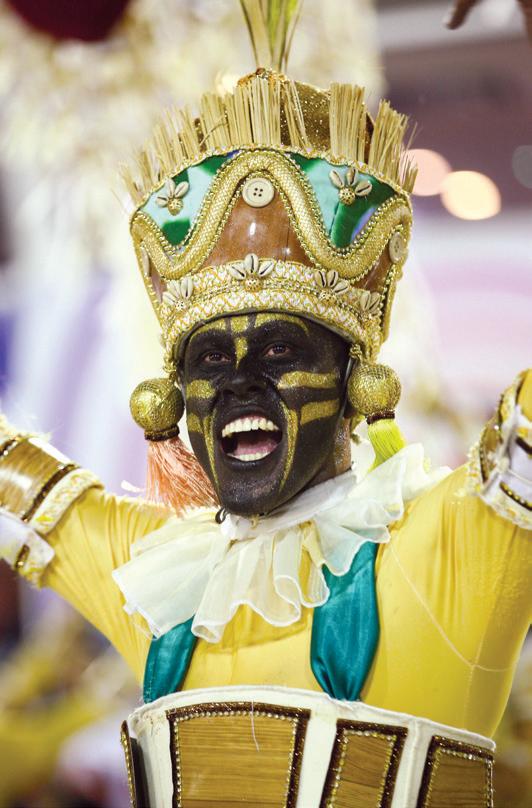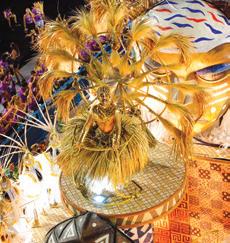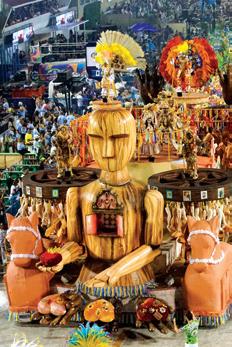
13 minute read
Acadêmicos do Cubango


Advertisement

Ficha Técnica | Technical Summary
Enredo | Theme - A VOZ DA LIBERDADE | THE VOICE OF FREEDOM Fundação - 17 de dezembro de 1959 | Established in December 17th, 1959 Presidente | President - Rogério Belizário Cores - Verde e Branco | Colors - Green and White Carnavalescos | Carnival Designers - Raphael Torres e/and Alexandre Rangel Diretor de Carnaval | Carnival Director - Tavinho Novello Diretor de Harmonia | Harmony Director - Allan Guimarães
5ª Escola - Entre 1h30 e 2h10 5th School - Between 1:30am and 2:10am Concentração: Correios | Meeting Point: Post Office
Sinopse do Enredo | Samba Theme Synopsis
O Acadêmicos do Cubango apresenta para o carnaval 2020 um tema cultural afrobrasileiro e resgata a fi gura de Luiz Gama na luta antirracista. | Acadêmicos do Cubango presents an Afro-Brazilian cultural theme for the 2020 Carnival and revisits the fi gure of Luiz Gama in the antiracist fi ght.

Cante com a Acadêmicos do Cubango
Sing along with Acadêmicos do Cubango
ENREDO: A VOZ DA LIBERDADE THEME: THE VOICE OF FREEDOM
Compositores | Songwriters:Robson Ramos, Junior Fionda, Rildo Seixas, Sardinha, Sergio Careca e/and Duda Tonon.
Intérprete | Singer: Thiago Brito
SE A IGUALDADE FOSSE COR? DE MAHIN NAGÔ É RAÇA PRA MORDAÇA NÃO VINGAR TENHO A RESISTÊNCIA COMO NINHO DE LUIZA O PASSARINHO QUE SE PERMITIU VOAR CERTO QUE NEGO LIBERTO, SEGURA A MÃO DO IRMÃO Ê SANGUE MALÊ, REBELIÃO ILÊ MEU SÃO SALVADOR SALVA A DOR DESSA GENTE ESCRAVA, DOLENTE QUE NÃO SE ENTREGA NÃO QUEBRA A CORRENTE
SEI DO MEU VALOR NÃO ME BOTE PREÇO NÃO, BOTE NÃO SENHOR QUE MEU POVO É BOM DE LUTA ALFORRIA FEZ MORADA EM MEU PEITO É PRETO SIM, MEU LEGÍTIMO DIREITO
TREMEU NA CASA GRANDE O OPRESSOR COM O PESO DA PALAVRA DE UM NEGRO QUANDO UM NOVO HORIZONTE VIVE MEU POVO É LIVRE! QUEM SOU EU? O BERRO CONTRA TODA TIRANIA CABRESTO NÃO SEGURA POESIA ENFIM UM CANTO FORRO ECOOU LUTE COMO UM DIA EU LUTEI UM SONHO, TANTAS VIDAS, UMA LEI MEU LUGAR DE FALA HOJE FAVELA, ONTEM SENZALA
A CHIBATA NÃO CANTOU, KABÔ LERÊ FIRMA NO BATUQUEJÊ, CUBANGO! UMA HISTÓRIA DE BRAVURA, TESTEMUNHA DA VERDADE EU SOU A VOZ DA LIBERDADE!
Acompanhe o Desfi le | Parade Sequence
1º SETOR: RAÍZES AFRICANAS 1ST SECTOR: AFRICAN ROOTS
COMISSÃO DE FRENTE | HONORARY COMMITTEE FANTASIA: A VOZ DA LIBERDADE COSTUME: THE VOICE OF FREEDOM COREÓGRAFO | CHOREOGRAPHER: PATRICK CARVALHO Retrata a luta pela liberdade nos tribunais, época em que a cor da pele era sinônimo de escravidão; caracterizada por grupo de escravos seguidos de seu algoz, traz a fi gura do abolicionista Luiz Gama - resgatando a dignidade do negro para se livrar das amarras da escravidão. | It portrays the struggle for freedom in the courts, a time when skin color synonymous of slavery; characterized by a group of slaves followed by their executioner, it brings the fi gure of the abolitionist Luiz Gama - rescuing the dignity of the black man to get rid of the bonds of slavery.
1º CASAL DE MESTRE-SALA E PORTABANDEIRA | 1ST MASTER OF CEREMONIES AND
FLAG BEARER COUPLE: DIEGO FALCÃO E/AND PATRÍCIA CUNHA FANTASIA: NOBREZA DO BENIN COSTUME: NOBILITY OF BENIN Os ancestrais da nobreza do antigo reino africano Benin, importante centro mercantil e fornecedor de escravos para a América. | The ancestors of the noble ancient African kingdom Benin, an important mercantile centre and supplier of slaves to America.
GUARDIÕES DO 1º CASAL DE MESTRE-SALA E PORTA-BANDEIRA GUARDIANS OF THE 1ST MASTER OF CEREMONIES AND FLAG BEARER COUPLE
FANTASIA: GUARDIÕES DA NOBREZA DE BENIN COSTUME: GUARDIANS OF THE NOBILITY OF BENIN 14 guardiões da nobreza de Benin são os fi éis escudeiros do casal de mestre-sala e porta-bandeira. 14 guardians of Benin’s nobility are the faithful squires of the master and fl ag-bearer couple.

1ª ALA: ANCESTRAIS DE BENIN 1ST WING: ANCESTORS OF BENIN (BAIANAS | WHIRLING LADIES) Os ancestrais de Benin, originários do Golfo, no Oeste da África, que foram trazidos como escravos para a América, inclusive a princesa do Reino do Benin: Luiza Mahin. | The ancestors of Benin, originally from the Gulf in West Africa, who were brought as slaves to America, including the princess of the Kingdom of Benin: Luiza Mahin.
1º CARRO – ABRE-ALAS: REINO DE BENIN OPENING FLOAT: THE KINGDOM OF BENIN O Reino de Benin, um dos mais poderosos da costa oeste da África, que foi atacado pelo tráfi co negreiro entre os séculos XVI e XIX. De onde proveio Luiza Mahin pertencente à nação nagô-jeje, da tribo Mahi, originária do Golfo do Benin, noroeste africano. | The Kingdom of Benin, one of the most powerful on the west coast of Africa, which was attacked by the slave trade between the 16th and 19th centuries. From where Luiza Mahin came from, belonging to the Nagô-jeje Nation, from the Mahi tribe, originally from the Gulf of Benin, Northwest Africa. DESTAQUES PRINCIPAIS: PAULO CÉSAR E TOM BRÍCIO - FANTASIAS: NOBREZA DE BENIN E ALTAR DOS ANCESTRAIS COMPOSIÇÕES: GUERREIROS DE BENIN E GUARDIÕES DA NOBREZA MAINS HIGHLIGHTS: PAULO CÉSAR AND TOM BRÍCIO - COSTUMES: NOBILITY OF BENIN AND THE ANCESTORS ALTAR COMPOSITIONS: WARRIORS OF BENIN AND GUARDIANS OF NOBILITY
2º SETOR: AS INSURREIÇÕES DOS ESCRAVOS 2ND SECTOR: THE INSURRECTIONS OF THE SLAVES
2ª ALA: TUMBEIRO | 2ND WING: TUMBEIRO A imigração forçada de muitos cativos africanos no Brasil para o uso da mão de obra escrava.| The forced immigration of many African captives in Brazil for the use of slave labor.
3ª ALA: PROVÍNCIA DA BAHIA 3RD WING: PROVINCE OF BAHIA A Província da Bahia, criada em 28 de fevereiro de 1821, palco do tráfi co de escravos e de inúmeras rebeliões. | The Province of Bahia, created on February 28, 1821, stage of the slave trade and numerous rebellions.
4ª ALA: CORTE DE BENIN | 4TH WING: BENIN’S CUT A corte de Benin vem retratada por Obá – rei do povo, e pelo leopardo, visto como rei dos animais. Num ritual que sinalizava poderio dos obás, os leopardos eram acorrentados e levados pelas ruas. The court of Benin is portrayed by Obá - king of the people, and by the leopard, seen as king of animals. In a ritual that signalised the power of the Obas, the leopards were chained and carried through the streets.
5ª ALA: RESISTÊNCIA NEGRA 5TH WING: BLACK RESISTANCE A resistência negra dos escravos em resposta à escravidão, com fugas individuais ou em massa, agressões contra senhores e outros tipos de resistência cotidiana. | The black resistance of slaves in response to slavery, with individual or mass escapes, aggressions against masters and other types of daily resistance.

6ª ALA: IMPOSIÇÃO DO CATOLICISMO 6TH WING: IMPOSITION OF CATHOLICISM A Igreja Católica e sua ideologia, que alegava que os negros africanos sofriam de maldição bíblica e os desumanizava justifi cando as violências que sobre eles eram acometidas. | The Catholic Church and its ideology, which claimed that black Africans suffered from a biblical curse and dehumanized them by justifying the violence that was infl icted on them.
7ª ALA: MALÊS | 7TH WING: MALIAN Grupo de origem nagô, os Malês praticavam a religião muçulmana e falavam o árabe; rebeldes, queriam o fi m do catolicismo, libertação e a implantação de uma república islâmica. | A group of Nagô origin, the Malians practiced the Muslim religion and spoke Arabic; rebels, they wanted an end to Catholicism, liberation and the establishment of an Islamic republic.
MUSOS | MUSES: MARIANE E/AND MATHEUS FANTASIA: LUIZA MAHIN E GUARDA NACIONAL COSTUME: LUIZA MAHIN AND THE NATIONAL GUARD
2º CARRO: REVOLTA DOS MALÊS 2ND FLOAT: MALIAN UPRISING A Revolta dos Malês, em Salvador, organizada pelos negros islâmicos, teve Luiza Mahin como articuladora, reunindo naquele dia, mais de 600 pessoas rebeladas. | The Revolt of the Males in Salvador, organized by the black Islamists, had Luiza Mahin as an articulator, gathering on that day, more than 600 rebellious people. DESTAQUE PRINCIPAL: MURILO RODRIGUES FANTASIA: RESISTÊNCIA MALÊ COMPOSIÇÕES: RESISTÊNCIA, MALÊS E SOLDADOS DO IMPÉRIO MAIN HIGHLIGHT: MURILO RODRIGUES COSTUME: MALIAN RESISTANCE COMPOSITIONS: RESISTANCE, MALIAN AND SOLDIERS OF THE EMPIRE
3º SETOR: MÃO DE OBRA ESCRAVA 3RD SECTOR: SLAVE LABOUR
MUSAS | MUSES: VALÉRIA E/AND FLÁVIA FANTASIA: ESCRAVAS NO CULTIVO DA CANA-DE-AÇÚCAR COSTUME: SLAVES IN SUGAR CANE FARMING
8ª ALA: ESCRAVO NO CULTIVO DA CANA-DEAÇÚCAR | 8TH WING: SLAVE IN SUGAR CANE FARMING A mão de obra do negro africano é representada pelo cultivo da cana-de-açúcar, grande riqueza agrícola e industrial do Brasil, base da economia colonial. | The African black man’s workforce is represented by the cultivation of sugar cane, Brazil’s great agricultural and industrial wealth, the basis of the colonial economy.
9ª ALA: ESCRAVO NO CULTIVO DO CAFÉ 9THWING: SLAVE IN COFFEE FARMING A mão de obra do negro africano foi o sustentáculo da economia nacional na produção do café, considerado o ouro verde, tendo os barões do café como a nova oligarquia que se estabelecia. | The black African manpower was the mainstay of the national economy in coffee production, considered the green gold, with the coffee barons as the new oligarchy that established.
MUSA | MUSE: ANGÉLICA FANTASIA: ESCRAVA NO CULTIVO DO ALGODÃO COSTUME: SLAVE IN COTTON FARMING

10ª ALA: ESCRAVO NO CULTIVO DO ALGODÃO 10TH WING: SLAVE IN COTTON FARMING Ainda na economia nacional, temos o cultivo do algodão nos latifúndios com a utilização de mão de obra escrava, cujo destino era o mercado externo e também as vestimentas dos escravos. | Still in the national economy, we have the cultivation of cotton in the latifundio with the use of slave labor, whose destination was the foreign market and also the clothes of the slaves.
RAINHA DA BATERIA | QUEEN OF PERCUSSION: MARYANE HIPÓLITO FANTASIA: DIAMANTE RELUZENTE COSTUME: GLISTENING DIAMOND
11ª ALA: ESCRAVO NAS MINAS DE DIAMANTE 11TH WING: SLAVE IN THE DIAMOND MINES (BATERIA | PERCUSSION) MESTRE | BANDMASTER: DEMÉTRIUS LUIZ Com a economia açucareira em crise, as atenções metropolitanas se voltaram para a exploração das minas de pedras preciosas, contagiando o mundo. With the sugar economy in crisis, metropolitan attention has turned to the exploitation of precious stones mines, spreading into the world.
CARRO DE SOM | SOUND CAR: INTÉRPRETE | SINGER: THIAGO BRITO
12ª ALA: ESCRAVO NAS MINAS DE OURO 12TH WING: GOLD MINER SLAVE (PASSISTAS | SAMBA DANCERS) Nas minas de ouro surge nova forma de exploração colonial, onde os negros africanos escravizados no Brasil eram utilizados na forma de trabalho mais penosa e cruel. | In the gold mines a new form of colonial exploitation emerged, where black Africans enslaved in Brazil were used in the most painful and cruel form of work.
MUSAS | MUSES: GLEICE E/AND RAFAELA FANTASIA: ESCRAVAS VENDEDORAS DE FLORES COSTUME: FLOWER SELLER SLAVES
13ª ALA: ESCRAVO VENDEDOR DE FLORES 13TH WING: FLOWER SALESMAN SLAVE Os escravos vendedores de fl ores atuavam no comercio ambulante pelas ruas da cidade. The slave fl ower sellers were active in the street trading of the city.
14ª ALA: ESCRAVA QUITUTEIRA 14TH WING: DELICACIES SLAVE (BAIANINHAS | WHIRLING GIRLS) As escravas quituteiras vendiam doces e quitutes provenientes de hábitos alimentares africanos, e carregavam em tabuleiros nos centros urbanos. Slaves cooked and sold sweets and delicacies from African eating habits, and carried them on trays in urban centres.
15ª ALA: ESCRAVO VENDEDOR DE FRUTAS 15TH WING: SLAVE FRUIT VENDOR Os escravos vendedores de frutas, chamados de quitandeiros, levavam suas mercadorias em cestos abertos pelas ruas da cidade. | The fruit seller slaves, called “quitandeiros”, carried their goods in baskets open through the streets of the city.
MUSOS | MUSES: JORGE E/AND THAIS FANTASIA: ESCRAVOS DE GANHO COSTUME: GAIN SLAVES
TRIPÉ: TRABALHO ESCRAVO URBANO TRIPOD: URBAN SLAVE LABOUR Os negros tomavam conta de pequenos comércios e vendiam alimentos das chácaras, sítios e fazendas do entorno da cidade, com cujo lucro poderiam se alimentar melhor ou comprar sua alforria. Black people took care of small businesses and sold food from the farms around the city, with whose profi t they could feed themselves better or buy their manumission. DESTAQUE CENTRAL: NEIDE JÚLIO E CARLINHOS SALGUEIRO FANTASIAS: NEGRA DE GANHO E ESCRAVO VENDEDOR DE FRUTAS CENTRAL HIGHLIGHTS: NEIDE JÚLIO AND CARLINHOS SALGUEIRO COSTUMES: BLACK OF GAIN AND FRUIT TRADER SLAVE
4º SETOR: A LUTA PELA LIBERDADE 4TH SECTOR: THE FIGHT FOR FREEDOM
16ª ALA: PRIMEIRAS TROVAS BURLESCAS 16TH WING: FIRST BURLESQUE SONGS O poeta Luiz Gama, inaugura a voz do afrodescendente nos quadros da literatura nacional com sua obra - Primeiras Trovas Burlescas. | The poet Luiz Gama, opens the voice of the afrodescendants in the national literature with his work – “First Burlesque Songs”.

2º CASAL DE MESTRE-SALA E PORTA-BANDEIRA 2ND MASTER OF CEREMONIES AND FLAG
BEARER COUPLE: RODRIGO MACHADO E/AND MARIANA AZEVEDO FANTASIA: O JORNAL DIABO COXO COSTUME: THE LAME DEVIL NEWSPAPER Luiz Gama inaugura a imprensa humorística, na cidade de São Paulo, ao fundar o jornal Diabo Coxo, em 1864. | Luiz Gama inaugurates the humorous press, in the city of São Paulo, when he founds the newspaper Diabo Coxo (Lame Devil), in 1864.
17ª ALA: DIABO COXO | 17TH WING: LAME DEVIL Luiz Gama passou a difundir com humor a sua oposição à elite e a tirar da ignorância a cidade que se encontrava afastada da Corte e do resto do Brasil. | Luiz Gama began to spread his opposition to the elite with humor and to remove from ignorance the city that was far from the Court and the rest of Brazil.
18ª ALA: BODARRADA | 18TH WING: BODARRADA O famoso poema “Quem sou eu”, mais conhecido como Bodarrada, foi escrito em resposta ao apelido que os intelectuais da época tentaram impor a Luiz Gama: bode, depreciação para designar os negros. | The famous poem “Who am I”, better known as “Bodarrada”, was written in response to the nickname that the intellectuals of the time tried to impose on Luiz Gama: goat, depreciation to designate blacks.
19ª ALA: ORFEU DE CARAPINHA 19TH WING: ORPHEUM OF CARAPINHA Autonomeado “Orfeu da Carapinha”, Luiz Gama foi precursor do abolicionismo no Brasil e poeta da negritude. | Self appointed “Orpheum of Carapinha”, Luiz Gama was a precursor of abolitionism in Brazil and a poet of negritude.
20ª ALA: JUSTIÇA NEGRA 20TH WING: BLACK JUSTICE Advogado autodidata, não se formou ofi cialmente por conta do racismo institucional no país, mas Luiz Gama conseguiu a liberdade de mais de 500 escravos, garantindo acesso jurídico a eles. | A self-taught lawyer, he did not offi cially graduate because of the institutional racism in the country, but Luiz Gama achieved the freedom of more than 500 slaves, guaranteeing legal access to them.
21ª ALA: TRIBUTO AO PATRONO DA ABOLIÇÃO 21ST WING: TRIBUTE TO THE PATRON OF ABOLITION (COMPOSITORES | SONGWRITERS) Luiz Gama, um dos raros intelectuais negros no Brasil, autodidata e único a ter passado pelo cativeiro, pautou sua vida na defesa da liberdade e da República. | Luiz Gama, one of the rare black intellectuals in Brazil, self-taught and the only one to have passed through captivity, guided his life in defense of freedom and the Republic.


MUSAS | MUSES: GRAMPOLA E/AND ALINE FANTASIA: DEUSAS DA JUSTIÇA COSTUME: GODDESSES OF JUSTICE
3º CARRO: TRIBUTO A LUIZ GAMA 3RD FLOAT: GAMMA LUIZ TRIBUTE Homenagem ao patrono da abolição da escravidão no Brasil, Luiz Gama, que, nos tribunais, usando de oratória impecável e bons conhecimentos jurídicos, conseguiu libertar mais de 500 escravos. | A tribute to the patron of the abolition of slavery in Brazil, Luiz Gama, who, in the courts, using impeccable oratory and good legal knowledge, managed to free more than 500 slaves. PERSONALIDADE: MILTON TEIXEIRA BASTOS FANTASIA: RESISTÊNCIA (HOMENAGEM AO ÚNICO FUNDADOR VIVO DA ACADÊMICOS DO CUBANGO) DESTAQUE CENTRAL: DÉO GARCEZ FANTASIA: LUIZ GAMA COMPOSIÇÕES: JUSTIÇA NEGRA PERSONALITY: MILTON TEIXEIRA BASTOS COSTUME: RESISTANCE (TRIBUTE TO THE ONLY LIVING FOUNDER OF ACADEMICOS DO CUBANGO) CENTRAL HIGHLIGHT: DÉO GARCEZ COSTUME: LUIZ GAMA COMPOSITIONS: BLACK JUSTICE








